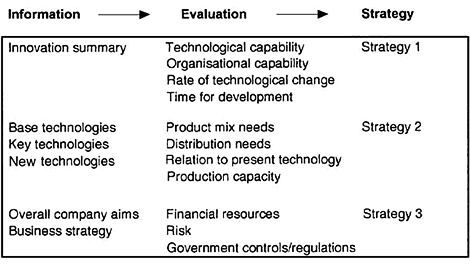FOOD
PRODUCT DEVELOPMENT
Mary Earle, Richard Earle and Allan Anderson |
| Loading
|
innovation |
|
||||
|
|
|
Part 2, Chapter 2
Developing an innovation strategy 2.2.2 Combining strategies - technology and innovation
The technology strategy for the company is also interwoven with the innovation strategy. In building the technology strategy it is essential first to identify the competence of the company with the present technologies and the ability to develop new technologies. A systematic method is used, comparing the technological competence of the company against other companies. This gives a truer indication of how technologically skilled the company is, rather than using subjective statements of company staff who may have vested interests in the present technology. It is difficult for outside consultants to assess the company's abilities for new technological areas. A combined project team with company staff and consultants using quantitative analysis is probably best for analysing technology competence throughout the company - raw materials, processing, distribution, marketing, and products. There is a need to study:
 base technologies that are necessary for the chosen product-market mix; base technologies that are necessary for the chosen product-market mix;
 key technologies which provide competitive advantage; key technologies which provide competitive advantage;
 new technologies, which could become tomorrow's key technologies. new technologies, which could become tomorrow's key technologies.
A technology mix needs to be developed for the future incorporating all of these. The technology strategy is related to the innovation possibilities that have been selected in the innovation summary, the product mix and the technology mix as well as the company's technological capabilities as shown in Fig. 2.7.  Fig. 2.7 Building the technology strategy. A technology strategy can identify:  new base or core technology that may lead to a range of new products; new base or core technology that may lead to a range of new products;
 base or core technology that is needed for an original new product; base or core technology that is needed for an original new product;
 key technology change that will be a unique competitive chance for key technology change that will be a unique competitive chance for the company;  improved technology that will lead to higher product quality, more varieties improved technology that will lead to higher product quality, more varieties of products or cost reductions. In developing a technology strategy, it is important to relate it to the products, consumers and markets. Sometimes a new processing or production technology may appear an attractive advance but may give product changes that are not recognised by the consumers or may even be unattractive to the consumer. Irradiation is a long-time technological innovation that has not come to be used because of consumer resistance to it. Genetically engineered crops are another instance today. It is also important to study the technological need, possession and lack of technology in the company and outside sources of technology, in developing the technology strategy:  In looking at new raw materials, some factors to study are shown in Table 2.4. Table 2.4 Factors in raw material innovation
Raw materials are an important technological area for innovation in the food industry, but consumer and political pressures today indicate that more care must be taken in sourcing them, so that the development and the production environment and methods are visible. Saying that the raw material pathways in international trade are too complex will not be an answer in the future - this may see more joint ventures in raw materials innovations. In the food industry, it is critical to combine the necessary production, processing and marketing technologies in technology innovation to ensure a successful innovation.
|
|
 |